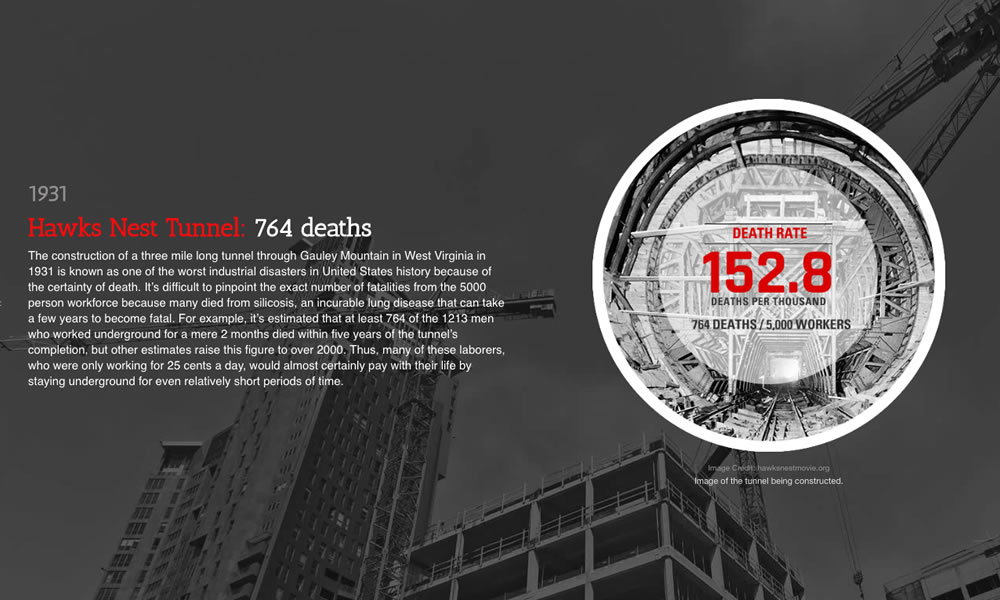What is Silica?
Often thought of as mere dust, silica is a component of natural minerals found on Earth that have been ground, cut, or drilled into a fine powder. Generally found in construction and related fields, these small particles can be inhaled and cause serious health issues or lead to the development of conditions such as tuberculosis or lung cancer.
One of the main effects of inhaling of silica is silicosis, which can cause scar tissue to build up in the lungs, inhibiting your ability to breathe and even leading to death. Silicosis comes in three different forms: chronic, which is the most common and comes from light exposure for a period of about 10 years, accelerated, which is caused by a high concentration with 5-10 years of exposure, and acute, which is caused by a brief but massive exposure to dust with high quartz content. Although each variation is preventable, it is still incurable to this day.
While it may not seem like the most pressing issue, it’s estimated that 2 million US workers are exposed to crystalline silica each year and between 1968 and 2002, it was an underlying or contributing cause on 74 million death certificates in the United States, 98% of which were male. Some of the highest risk professions include:
- Coal Miners
- Construction Workers
- Oil Drillers
- Farmers
- Manufacturers
- Stone Cutters
- Ship Builders
- Railroad Workers
The Hawks Nest Tunnel DISASTER
There are also examples of serious tragedies involving silica, such as the construction of West Virginia’s Hawks Nest Tunnel in 1931. According to a group of personal injury attorneys in Orange County who created an interactive timeline comparing the human cost of construction of the world’s most deadly construction projects, the Hawks Nest Tunnel is known as the worst industrial disaster in United States history and one of the most deadly projects that the modern world has seen, with a death rate of 152.8 workers per every 1,000. Furthermore, these numbers rely on conservative estimates, meaning the truth death toll could be even higher.

Because of tragedies like this and public concern over the health of laborers, the introduction of safety standards in the 1970s by groups such as the the Occupational Safety and Health Administration (OSHA) and Mine Safety and Health Administration (MSHA) have let to the sharp decline in silica related fatalities in the United States as shown above.
New OSHA Standards
Even with the increased attention given to silica related fatalities, many labor organizations believe that regulations have not gone far enough. On March 25 of this year, OSHA introduced a new set of standards when it comes to silica in work related settings. The new rule cuts the permissible exposure limit (PEL) for silica dust to 50 µg/m3, averaged over an eight hour day. This limit is two to five times lower than the current PEL, depending on the industry, and it’s estimated that this change could save up to 600 lives a year.
However, a legal battle has emerged over these new rules. One camp, led by labor interests, believes that the reform is not expansive enough and suggests that the PEL should be even further reduced to 25 µg/m3 or lower where feasible. The other camp, led by construction and manufacturing interests, says that the new rule is both too stringent and costs too much. They argue that that further standards require more testing which could produce inconsistent and unreliable data, as well as tacking on an estimated $1 billion in costs to enact the new rule.
Currently, the new rule becomes effective on June 23, 2016 with varying amounts of time for compliance based on the industry, but there have been many petitions for review which are being consolidated in the D.C. Circuit of the U.S. Court of Appeals. Only after the pending litigation is finished will there be a clear decision on the plausibility of the new silica program.
Therefore, the current legal battle comes down to an age old argument – is the potential protection of lives worth the price? Dividing the $1 billion by the estimated 600 lives saved yields a rate of about $1.7 million per life, and it will be up to the U.S. Court of Appeals to determine if this is indeed a fair cost to benefit ratio.